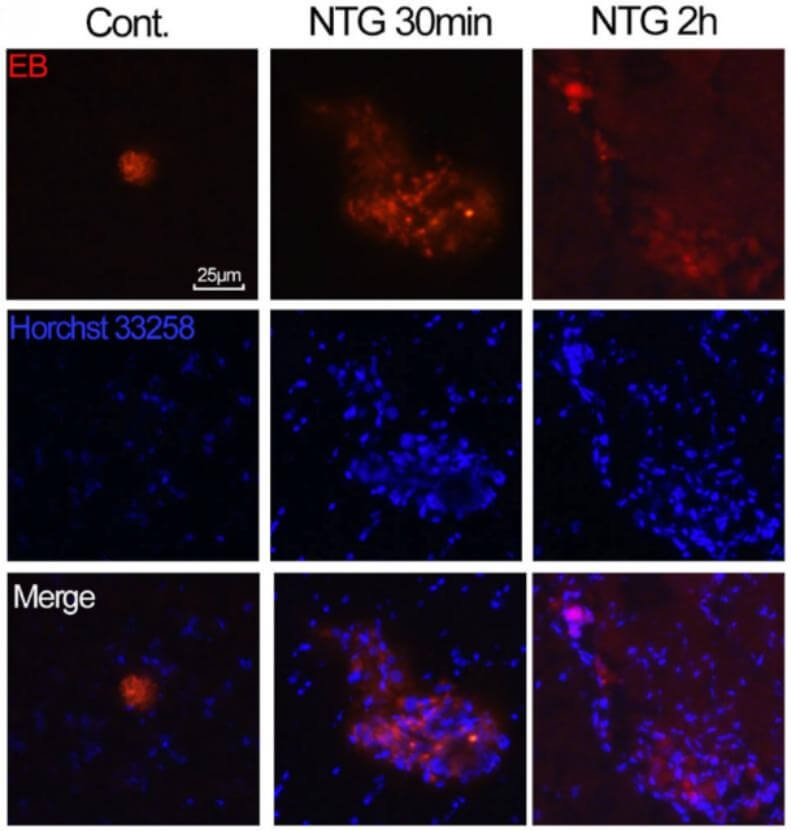Nitroglycerin (NTG) induced Migraine Modeling & Pharmacodynamics Service
Among the numerous models proposed as in vivo systems for testing novel antimigraine drug candidates, the most widely studied and accepted one is the nitroglycerin (NTG)-induced model of migraine. Creative Biolabs offers drug efficacy testing services of novel antimigraine drugs in both rat and mice nitroglycerin fusion models. Moreover, a comprehensive battery of assessment tools is employed, allowing us to offer customized protocols and study designs.
Introduction of NTG Model of Migraine
NGT infusion is the most widely used and trustworthy method to provoke migraine-like headaches in humans as well as in animals. The infusion of the nitric oxide donor NTG results in upregulation of proinflammatory mediators, macrophage activation, edema formation, and mast cell degranulation by its direct action on meningeal tissues and produces plasma protein extravasations (PPE).
 Fig. 1 Images of EB staining in the TNC of rats with NTG-induced migraine.1
Fig. 1 Images of EB staining in the TNC of rats with NTG-induced migraine.1
NGT is metabolized to nitric oxide (NO) by a combination of glutathione-S-transferase, cytochrome P450, and thiol reactions. Type II nitric oxide synthase (NOS) is expressed by macrophages and can be activated by NGT. After some hours of NGT infusion, iNOS generates NO at 100-1000 fold than its constitutive counterparts and promotes inflammation and the development of migraine. NGT activates second-order nociceptors, NF-ĸB, and increases the expression of c-fos, neuronal nitric oxide synthase (nNOS), and calmodulin-dependent protein kinase II in the trigeminal nucleus caudalis. Increased production of NO has been reported to upregulate COX, TNF-a, and matrix metalloprotease-9 (MMP-9).
Features of NTG Model of Migraine
- It is the most widely used and reliable animal model for inducing migraine-like attacks in animals. The important details of GTN-induced migraine, such as headache time profile, pain characteristics and accompanying symptoms have been carefully investigated.
- For induction of migraine, the dose of NGT used for infusion is about 8-10 times higher than in humans.
- One of the most important advantages of the NGT-triggered headache model is the temporal control of events following NGT administration.
Assessments
Creative Biolabs conducts a comprehensive battery of assessments for efficacy evaluation of putative antimigraine drugs. For instance, cranial blood perfusion can be measured by laser Doppler flowmetry technique. Level of inflammatory mediators like TNF-α and mRNA and protein expression for c-fos is analyzed in the trigeminal vascular system at various time points using ELISA, RT-PCR, and immunohistochemistry. Hypersensitivity to pain either on the paw/tail or in the facial (trigeminal) region is measured by behavioral responses to chemical, mechanical or thermal stimuli. Briefly, the assessments provided by Creative Biolabs include:
- Electrophysiology analysis of electrical activity
- Intravital video microscopy for blood vessel visualization
- Laser Doppler flowmetry to measure blood flow changes
- Histology/ Immunohistochemistry
- Evoked behavioral testing for allodynia and hyperalgesia measurement
- Spontaneous behavioral testing (e.g., facial grimace, blinking, rearing, gnawing)
- Behavioral tests for motor function and cognition
You may also be interested in:
The neurological platform of Creative Biolabs provides an extensive range of neurological disease models. If you are interested, click the following links for more detailed description of each model:
Supported by PhD-level scientists, state-of-the-art facilities, and abundant project management experience, Creative Biolabs is capable of providing and delivering robust preclinical in vivo contract drug discovery and development services. Contact us for more information on these models or if you would like to customize a model.
Reference
- Chen, Hao, et al. "IL-17 crosses the blood–brain barrier to trigger neuroinflammation: a novel mechanism in nitroglycerin-induced chronic migraine." The Journal of Headache and Pain 23 (2022): 1-18. Distributed under Open Access license CC BY 4.0. The image was modified by extracting and using G part of the original image.
For Research Use Only.
